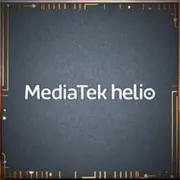MediaTek Helio X23

MediaTek Helio X23: Review of the Mid-Range Smartphone Processor
April 2025
Introduction
The MediaTek Helio X23 is a mobile system-on-chip (SoC) released in 2024, positioned as a solution for mid-range devices. Despite the active market shift towards 5G and neural network acceleration in 2025, the Helio X23 remains relevant due to its balance of price and performance. In this article, we will explore who this processor is suitable for, what tasks it can handle, and what to watch out for when choosing a smartphone based on it.
1. Architecture and Process Technology
Cores and Frequencies:
The Helio X23 is built on a hybrid Tri-Cluster architecture with 10 cores:
- 2 ARM Cortex-A72 cores with a frequency of up to 2.3 GHz for resource-intensive tasks (gaming, rendering).
- 4 ARM Cortex-A53 cores with a frequency of 1.85 GHz for background processes.
- 4 ARM Cortex-A53 cores with a frequency of 1.4 GHz for energy efficiency (social media browsing, music).
This configuration allows for flexible load distribution, reducing power consumption. However, the 20 nm process technology (which is considered outdated in 2025) limits efficiency: prolonged load can lead to overheating.
Graphics:
The Mali-T880 MP4 GPU is a quad-core graphics processor with a frequency of up to 780 MHz. It supports resolutions up to 2560×1600 pixels and APIs Vulkan 1.0, OpenGL ES 3.2. For modern games like Genshin Impact or Honkai: Star Rail, the power is only sufficient for low graphics settings (30-40 FPS).
2. Performance in Real-World Tasks
Gaming:
- Casual gaming (PUBG Mobile Lite, Candy Crush) — perfect.
- Heavy projects — require lowering graphics settings. For example, in Call of Duty: Mobile, a stable FPS (45-50) is only possible in "Medium graphics" mode.
Multimedia:
- Supports 4K@30fps video (recording and playback).
- Hardware decoding for H.265, VP9 — streaming content on Netflix or YouTube runs smoothly.
Artificial Intelligence:
There is no dedicated NPU in the SoC, so tasks like face recognition or photo processing are handled through the CPU/GPU. This slows down applications with AI filters (e.g., Adobe Lightroom Mobile).
Power Consumption:
With moderate use (social media, calls), a smartphone on Helio X23 lasts 1-1.5 days on a charge. However, in gaming or 4K recording, a 4000 mAh battery drains within 3-4 hours.
Heat Generation:
Due to the 20 nm process technology, the chip heats up under load. In devices without a liquid cooling system, throttling (a 15-20% CPU frequency drop after 15 minutes of gaming) may occur.
3. Integrated Modules
- Modem: Cat-12 LTE (up to 600 Mbps download), no 5G support.
- Wi-Fi: 802.11ac (Wi-Fi 5), but no support for Wi-Fi 6/6E.
- Bluetooth: 5.0 (A2DP, LE).
- Navigation: GPS, GLONASS, BeiDou.
The lack of 5G is a significant downside in 2025. However, in regions where LTE still dominates (e.g., parts of Africa, some parts of Asia), this may not be critical.
4. Comparison with Competitors
MediaTek Helio X23 vs Snapdragon 680:
- The Snapdragon 680 (6 nm, 8 Kryo 265 cores) excels in energy efficiency and single-core task speed (Geekbench 6 Single-Core: 320 vs 242).
- In multi-threaded performance, Helio X23 performs better (859 vs 800) thanks to its 10 cores.
MediaTek Helio X23 vs Kirin 710A:
- The Kirin 710A (14 nm, Mali-G51 MP4) is weaker in GPU performance but more stable in terms of heat management.
Conclusion: Helio X23 is a good option for those who prioritize multitasking over peak performance.
5. Use Cases
Gaming:
Suitable for mobile game enthusiasts who don’t require ultra-settings. It is recommended to choose models with active cooling (for example, Blackview A90).
Everyday Tasks:
- Smooth operation in Chrome, Telegram, YouTube.
- Simultaneous launching of 5-7 applications without noticeable lag.
Photo and Video:
- Supports cameras up to 48 MP (with EIS support).
- Night shooting requires software optimization—without an AI chip, there will be more noise.
6. Pros and Cons
Pros:
- Low cost devices ($150–$250).
- Good multitasking capabilities.
- Support for 4K video.
Cons:
- Outdated process technology (heating issues).
- Weak GPU for 2025 standards.
- No 5G or Wi-Fi 6.
7. Practical Tips for Choosing a Smartphone
1. Cooling: Look for models with copper pipes or graphite coatings.
2. Battery: At least 5000 mAh to compensate for high power consumption.
3. Display: Full HD+ (1080×2400) — higher resolution is pointless due to GPU limitations.
4. Memory: At least 6/128 GB — background processes consume RAM.
Typical Devices:
- Budget smartphones (Tecno Spark 12 Pro).
- Rugged devices (Blackview BV6600).
- Models with large batteries (Xiaomi Redmi Note 14 Lite).
8. Final Conclusion
Who is Helio X23 Suitable For?
- Users looking for an affordable smartphone for social media, calls, and light gaming.
- Those living in regions without 5G coverage.
- Fans of long battery life (provided there is a high-capacity battery).
Main Benefits:
- Lower price compared to 5G alternatives.
- Reliable performance in basic scenarios.
Alternatives: If your budget allows an additional $50-70, consider Snapdragon 7 Gen 2 or Dimensity 8000 — they offer 5G and better future-proofing.
Conclusion
The MediaTek Helio X23 represents a compromise option in 2025. It won’t impress with speed but will serve as a reliable companion for those who appreciate the balance of price and functionality. When choosing a device based on this SoC, pay attention to cooling and battery — these are key factors for comfortable use.
Basic
GPU Specifications
Benchmarks
Compared to Other SoC
Share in social media
Or Link To Us
<a href="https://cputronic.com/soc/mediatek-helio-x23" target="_blank">MediaTek Helio X23</a>